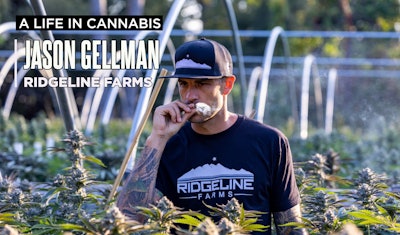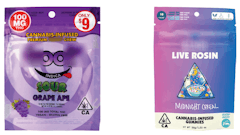
Jason Gellman remembers when farmers in his hometown of Garberville could sell a pound of their Humboldt County cannabis for $5,000. That was back around 1990, when the California county known for growing the best weed on planet Earth served most of the American West and large swaths of the entire country.
In just five years, the price per pound had cut in half. Then, by 2015, to $1,500. When California’s licensed adult-use cannabis program came online with dispensary sales in 2018, the price dropped to $1,000. Last year it was $300 per pound, and this year it’s barely $250, Gellman said.
Wholesale cannabis prices vary for indoor, greenhouse and outdoor growers, but the common trajectory has been downward across California’s entire supply chain.
“Even if every small farmer in Humboldt quit today, it wouldn’t matter,” Gellman said. “There are one or two mega-farms down south that can supply all of California.”
 Ridgeline Farms in Southern Humboldt CountyCourtesy of Justin Bowers, Ridgeline Farms
Ridgeline Farms in Southern Humboldt CountyCourtesy of Justin Bowers, Ridgeline Farms
Once known for its supply during decades of marijuana prohibition, Ridgeline Farms has taken on a new purpose to survive in California’s flooded legal cannabis market. Gellman, 46, now focuses more than ever on genetics and expanding his brand outside of the Golden State.
He embarks on regular pheno-hunts, which include testing up to 170 different strains, identifying his 15 favorites, and narrowing them down to the two absolute best strains to enter in the region’s most prestigious competitions. That process has led to countless awards, which in turn make the Ridgeline brand and genetics sought-after commodities for vendors and growers across the world.
A Life in Cannabis, Then Overnight Success
 Blackberry CaviarCourtesy of Justin Bowers, Ridgeline Farms
Blackberry CaviarCourtesy of Justin Bowers, Ridgeline Farms
“Winning first place that year was absolutely surreal,” Gellman said. “One day I was an outlaw; the next I had a hundred cameras in my face.”
More success followed. Ridgeline’s Runtz strain earned the farm another first-place award in 2019’s Emerald Cup, then was named Leafly’s 2020 strain of the year. The farm also placed in several other national awards every year after that, through 2025.
 Blueberry CaviarCourtesy of Justin Bowers, Ridgline Farms
Blueberry CaviarCourtesy of Justin Bowers, Ridgline Farms
Gellman designed Blueberry Caviar by crossing Grape Gas and Lantz strains, but he admits it wasn’t his personal favorite of the dozens of strains he created this year. He instead preferred a closely related Blackberry Caviar, which also earned a respectable bronze medal at the California Cannabis Awards.
“I can look at a strain, smell it, smoke it, and just know when it’s a winner,” Gellman said. “I was really proud of both of those.”
Growth Through Big-Name Partnerships
Gellman can’t push his farm-grown products beyond state borders under federal prohibition, but partnering with the likes of mega-brands like Cookies and Heavy Hitters has Ridgeline strains on dispensary shelves in over 20 states. Through his connections with Cookies head man Berner and other famous pot-repreneurs, including Woody Harrelson, Gellman has also sold Ridgeline genetics to vendors in Thailand, Colombia, Australia and Germany.
He’s constantly looking for ways to differentiate his strains from everyone else. A prime example: This year, Gellman began using feminized pollen and seeds for the first time, pollinating about 40 strains using feminine pollen.
“You can’t make it by selling the same clone from the same nursery as everyone else,” he said. “A brand has to have unique genetics. That’s the number one thing to survive.”
A Silver Lining for Recession-Stricken Southern Humboldt County
 Jason Gellman inspects his plants. Courtesy of Justin Bowers, Ridgeline Farms
Jason Gellman inspects his plants. Courtesy of Justin Bowers, Ridgeline Farms
Gellman said the region has “hardly any jobs left,” and he personally knows of five growers who moved elsewhere in recent months to find work.
Storefronts in Garberville, a town of about 1,500 residents, are all boarded up, he said. And no more than two restaurants are still open.
“You could almost put a ‘closed’ sign on Garberville right now,” Gellman said.
As California’s cannabis oversupply continues to get worse, will the area become a complete ghost town, referenced only for historical purposes in the future? Gellman isn’t ready to give up on his hometown just yet. He claims Southern Humboldt County’s cannabis economy is “98 percent in the red,” due in part to locals not knowing how to market their product beyond California.
A change in strategy, he said, is the first step forward.
“Most of the community has just continued to stay their course and grow weed and try to make money,” he said. “But one of the best ways to have success is to sell genetics to partner brands that can help your brand expand into new markets.”
Gellman acknowledged that with more regulated cannabis markets developing across the country, the chances of Humboldt again becoming America’s most prominent weed supplier are slim to none. Still, he believes the county can one day return to prosperity.
Besides farmers finding new ways to extend their reach with genetics, Gellman predicts a future economy dependent on tourism, hospitality and smoke-friendly venues to attract new business and make the heartland of cannabis culture thrive once again.
























